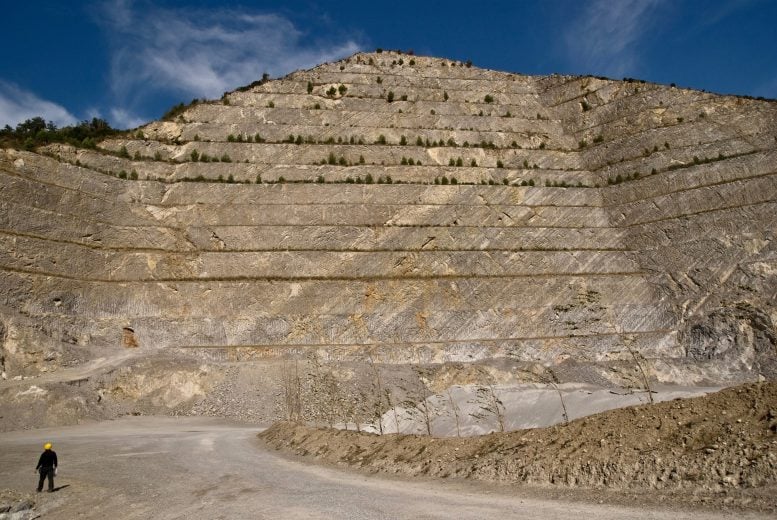
Around 183 million years ago, during the Toarcian Oceanic Anoxic Event (T-OAE), volcanic eruptions in what is now South Africa released approximately 20,500 gigatons of carbon dioxide (CO2) into the atmosphere and oceans over a span of 300 to 500 thousand years. This significant influx of CO2 led to severe oxygen depletion in marine environments, resulting in a widespread extinction of marine life.
Human activity since the industrial revolution has already resulted in cumulative CO2 emissions representing 12 percent of the total CO2 released during the entire T-OAE, in less than 0.1 percent of the time. The T-OAE foreshadows what might happen to our oceans if greenhouse gas emissions continue to increase.
Scientific Analysis of Ocean Deoxygenation
“You can see lots of fossils within ocean sediments before the T-OAE, and then suddenly they disappear,” says Caltech’s Francois Tissot, Professor of Geochemistry and Heritage Medical Research Institute Investigator. Tissot is a co-author on a new study, published on June 24 in the journal Proceedings of the National Academy of Sciences, describing the extent of the ocean anoxia during the T-OAE.
Led by researchers from George Mason University, the team collected thirty samples of stratified limestone from the Mercato San Severino region in southern Italy to assess the severity of ocean deoxygenation during the T-OAE.
The team analyzed the samples for their uranium content and isotopic composition. Isotopes are twin version of an element with different number of neutrons, and thus very slightly different masses. The relative abundance of isotopes of uranium in the ocean depends on the amount of anoxia. This means that by measuring the isotopic composition of uranium in the ocean, scientists can infer the amount of anoxia in the ocean. In the absence of actual seawater samples from the past, scientists are able to use a proxy for it, such as carbonate rocks, which record faithfully the seawater composition.
When there is plenty of oxygen in the ocean, uranium likes to stay in its soluble form, dissolved in the seawater. But when oxygen in the water becomes more scarce, then uranium begins to precipitate out of the seawater, and settles into sediments on the ocean floor. Thus, through careful modeling developed by former Caltech postdoctoral scholar Michael Kipp, Tissot, and collaborators, the amount of uranium in seafloor samples can indicate the percentage of oxygen in the ocean at the time of the T-OAE.
Impact of Anoxia on the Ocean Floor
“Using this model, we found that anoxia peaked at 28 to 38 times of the modern ocean,” says Tissot. “Today, only about 0.2 percent of the ocean floor is covered with anoxic sediments, similar to those found in the Black Sea. At the time of the T-OAE, 183 million years ago, it was 6 to 8 percent of the ocean floor that was covered in anoxic sediment.”
The results indicate that past OAE events can foreshadow the effects of anthropogenic CO2 emissions on marine ecosystems.
“If we don’t curb carbon emissions and continue on an increasing CO2 trajectory, we can clearly see that there will be severe negative impacts on the ocean’s ecosystem,” says Tissot.
Reference: “Carbonate uranium isotopes record global expansion of marine anoxia during the Toarcian Oceanic Anoxic Event” by Mariano N. Remírez, Geoffrey J. Gilleaudeau, Tian Gan, Michael A. Kipp, François L. H. Tissot, Alan J. Kaufman and Mariano Parente, 24 June 2024, Proceedings of the National Academy of Sciences.
DOI: 10.1073/pnas.2406032121
7 Comments
That’s apples and oranges. Greenhouse effect has got nothing to do with that recent 183 million years ago.
Getting choked on CO2 is something entirely different than getting warmed up with the help (maybe!) of CO2.
This story doesn’t fit your agenda whatsoever and it’s pathetic to see you struggling to stretch it to fit.
That’s apples and oranges. Greenhouse effect has got nothing to do with that event 183 million years ago.
Getting choked on CO2 is something entirely different than getting warmed up with the help (maybe!) of CO2.
This story doesn’t fit your agenda whatsoever and it’s pathetic to see you struggling to stretch it to fit.
>Getting choked on CO2
That’s ridiculous. Oxygen levels won’t be a problem for like 200 more years. Which would be a huge problem of course, but it’s not the biggest one right now.
>entirely different than getting warmed up with the help (maybe!) of CO2.
What matters is that warming is happening too quickly, there is not enough time for adaptations & slow migrations etc..
“What matters is that warming is happening too quickly, there is not enough time for adaptations & slow migrations etc..”
Yet, there were no mass extinctions during the temperature spike called the Paleocene-Eocene Thermal Maximum, which has often been called an analogue to what is happening today. Rather, the Eocene was a period of expansion and diversification of mammalian life. How does that square with your concern that “warming is happening too quickly?”
Sounds like interesting exploratory work. However, modeling may be useful in pointing research in a certain direction but does not assure that direction is correct. What I did not see was the CO2 or uranium numbers prior to the T-OAE. Without a baseline the recent numbers are unbounded.
The fake science crowd have been lying about global warming now for over 60 years and every 5 years its going to be an apocalypse that kills us all!!!!!!
Enough already. You don’t actually understand science and never will.
Can someone explain how increasing Co2 deoxygenates the ocean? Given a current Co2 level of 400 ppm, it surely cannot be simple displacement. Even doubling that would still leave Co2 at far less than 1%. That is, we’ll never produce enough Co2 to have a significant impact on the percentage of atmospheric oxygen. So, there must be some other mechanism at work that isn’t explained here. Can someone clarify?